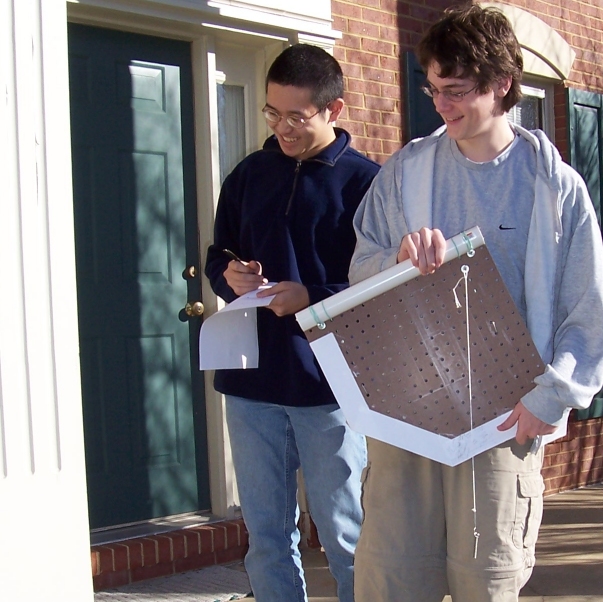|
Author
|
Topic: Sun sights using a plumb-bob sextant
|
Dave S
|
 posted January 31, 2007 05:44 PM
posted January 31, 2007 05:44 PM


This post refers to E.N., 1990 paperback edition, p.154.
It occurred to me that one way to take a sun sight without risking one's eyesight would be to allow the shadow of the tube to fall on some sort of screen -- anything small, flat, and light-colored should do -- and judge when the tube is pointing at the sun by the symmetric appearance of the circular shadow. As with the conventional direct sight, two people are better than one, and in this case, three are even better: one to orient the device, one to read the position of the string, and if available, one to hold the screen. (The screen-holder is a relatively low-skilled position compared to the other two.)
I have tried this technique on land. The quality of the shadow and its sensitivity to the alignment of the tube will depend, of course, on the length and diameter of the tube as well as its wall thickness. Being on land, I had my choice of materials, and I used a 1-1/2" PVC pipe about 2 feet long whose wall is just over 1/8" thick. I also used a piece of pegboard and some bolts, which solved at once the problem of mounting the pipe, anchoring the string, and measuring the angles (using a pocket calculator with arctan function).
In my trial, I did not use conventional sight reduction. Being on land, I took many measurements during a quiet, sunny day, did some interpolation to determine the time of LAN, and also made a lot of closely spaced measurements near that time to determine the sun's maximum altitude. With all this data, I got within +/- 15' in both latitude and longitude.
I'm not sure how well it would work if I did it again, though. Due to the large number of raw measurements involved, this result should probably be considered the average of several conventionally-reduced sights, but I have not formally worked out anything about how to interpret the statistics.
A version of this gadget eventually found its way into a high school science project for one of my kids.

I just happen to be interested in navigation but I have no boating experience whatsoever, so I don't know how much of this would be practical at sea. Probably not much. But, the main idea is that of using a shadow rather than a direct sight to aim the plumb-bob sextant at the sun, and I think that might still be applicable.
Any thoughts?
From: Virginia
|
|
David Burch
|
 posted January 31, 2007 09:21 PM
posted January 31, 2007 09:21 PM


This is an interesting result, and i think one that could be adapted to use at sea, at least in calm conditions.
You say the pipe as about 2 feet. is the one in the picture the one you refer to... or is this a smaller one. If these holes in the board are 1 inch then this one seems about 16 inches long?
And with this one, it would seem your angle is measured as a right angle with sides of 12 inches and about 5.2 inches. Do i understand right, in that you would then compute the angle based on the length of the two sides figured from the pegboard holes (or actually measured along those lines).
From: Starpath, Seattle, WA
|
|
Dave S
|
 posted February 01, 2007 05:10 AM
posted February 01, 2007 05:10 AM


The post refers to the first version, never photographed. The science project shown in the photo was built a little bit smaller. I think the reason was that the original larger one was a bit unwieldy. The original size was chosen because the local home improvement store sells pegboard in 2'x2' sheets.
Angle measurement was made by making a pencil mark on the paper rim, counting the holes to get close, then using a small ruler to get the last fraction of an inch. Then you get the tangent of the angle from the two lengths, and get the angle using a calculator. So, the holes make the measurement more convenient and you can do it with any small ruler or even estimate it pretty closely by successively bisecting the last inch by eye with pencil marks. I'm guessing that that way you could get to 1/16" pretty reliably, which should bring the angle measurement near the 1% range for precision. At that point, the thickness and motion of the string, and of course the orientation of the tube, are larger sources of error, I think. I haven't figured out how that propagates into lat/lon, nor the expected effect of the many measurements on the overall accuracy.
From: Virginia
|
|
|









